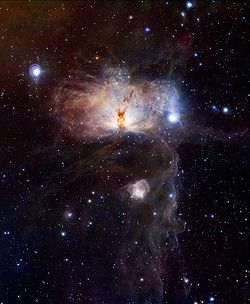Mlhovina Plamínek
| Mlhovina Plamínek | |
|---|---|
 Mlhovina Plamínek | |
| Pozorovací údaje (Ekvinokcium J2000,0) | |
| Typ | emisní mlhovina |
| Objevitel | William Herschel |
| Datum objevu | 1786 |
| Rektascenze | 05h 41m 54s |
| Deklinace | -01°51'00" |
| Souhvězdí | Orion (lat. Ori) |
| Vzdálenost | 900 - 1 500 ly |
| Označení v katalozích | |
| New General Catalogue | NGC 2024 |
| Jiná označení | NGC 2024, Sh2-277 |
| (V) – měření provedena ve viditelném světle | |
| Některá data mohou pocházet z datové položky. | |
Mlhovina Plamínek (NGC 2024) je emisní mlhovina ležící v souhvězdí Orionu zhruba 900 až 1 500 ly od Slunce. Mlhovinu objevil 1. ledna 1786 William Herschel a nachází se v blízkosti hvězdy Alnitak (východní hvězda Orionova pásu).
Červené zbarvení je důsledkem zářením ionizovaných atomů vodíku na kraji velkých molekulárních mračen. Středový tmavý pruh mezihvězdného prachu ukrývá zdroj kupu horkých, mladých hvězd. Ty je možné spatřit v infračervené části spektra. Některá z hmotných hvězd je nejspíše zdrojem energetického ultrafialového záření, které ionizuje vodík.[1]
Odkazy
Externí odkazy
 Obrázky, zvuky či videa k tématu Mlhovina Plamínek na Wikimedia Commons
Obrázky, zvuky či videa k tématu Mlhovina Plamínek na Wikimedia Commons
Reference
- ↑ Plamínek zblízka [online]. Česká astronomická společnost [cit. 2012-01-12]. Dostupné online. (česky)
Média použitá na této stránce
Autor: ESO/J. Emerson/VISTA. Acknowledgment: Cambridge Astronomical Survey Unit, Licence: CC BY 4.0
This VISTA image shows the spectacular star-forming region known as the Flame Nebula, or NGC 2024, in the constellation of Orion (the Hunter) and its surroundings. In views of this evocative object in visible light the core of the nebula is completely hidden behind obscuring dust, but in this VISTA view, taken in infra-red light, the cluster of very young stars at the object’s heart is revealed. The wide-field VISTA view also includes the glow of the reflection nebula NGC 2023, just below centre, and the ghostly outline of the Horsehead Nebula (Barnard 33) towards the lower right. The bright bluish star towards the right is one of the three bright stars forming the Belt of Orion. The image was created from VISTA images taken through J, H and Ks filters in the near-infrared part of the spectrum. The image shows the full area of the VISTA field and is one degree by 1.5 degrees in extent. The total exposure time was 14 minutes.
